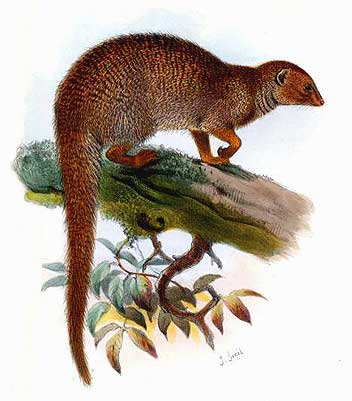Herpestes edwardsii Cladus: Eukaryota Name Herpestes edwardsii E. Geoffroy Saint-Hilaire, 1818 References * Herpestes edwardsii on Mammal Species of the World.
--------- The Indian Gray Mongoose or Common Grey Mongoose (Herpestes edwardsii) is a species of mongoose found in southern India and Sri Lanka. The gray mongoose is commonly found in open forests, scrub lands and cultivated fields, often close to human habitation. It lives in burrows, hedgerows and thickets, among groves of trees, taking shelter under rocks or bushes and even in drains. It is very bold and inquisitive but wary, seldom venturing far from cover. It climbs well. Usually found singly or in pairs. It preys on rodents, snakes, birds’ eggs and hatchlings, lizards and variety of invertebrates. Along the Chambal river it occasionally feeds on gharial eggs. It breeds throughout the year. Description The Indian grey mongoose, or common grey mongoose is a medium sized tawny or yellowish grey with a lighter underside, darker feet (this separates it from the syntopic Small Asian Mongoose), and dark red tail tip. They have a reddish tint to their heads. Their tail length equals their body length. Body length: 14-17 inches (36-45cm) Tail length: 17 inches (45 cm), weight: 2-4 lb. (0.89-1.7kg). Males are significantly larger than the females 1. ^ Choudhury, A., Wozencraft, C., Muddapa, D., Yonzon, P., Jennings, A. & Geraldine, V. (2008). Herpestes edwardsii. In: IUCN 2008. IUCN Red List of Threatened Species. Downloaded on 22 March 2009. Database entry includes a brief justification of why this species is of least concern Source: Wikispecies, Wikipedia: All text is available under the terms of the GNU Free Documentation License |
|


